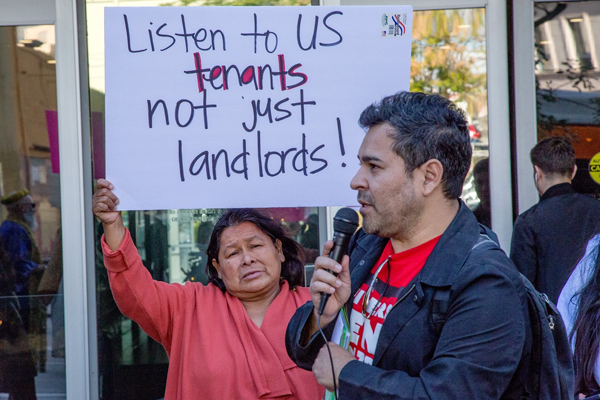Trending
The eviction gamble

It’s a tough time to be a renter in Los Angeles. Then again, it’s a tough time to be a landlord, too.
L.A.’s multifamily market is hotter than ever, particularly in the neighborhoods surrounding Downtown. But due in part to the layers of bureaucratic red tape surrounding development, inventory is tight: Housing units from new construction increased by less than half a percent, to 16,600, in L.A. County in 2016. Demand is so high that L.A. has been named the most unaffordable city for renters and buyers in all of the U.S., according to a new report from the UCLA Anderson School of Management.
With market-rate rents edging ever higher, landlords of rent-controlled units see their losses pile up. Thus, they have huge incentives to upgrade their older, rent-regulated properties into market-rate buildings, no matter what construction-related headaches they encounter. But first, they must navigate the city’s tenants’ rights laws in order to move rent stabilized tenants out.
A look at the numbers suggests that in the past few years, landlords have had increasing success doing just that. Last year, under the Ellis Act — the state law allowing landlords to evict tenants of rent-stabilized units if they plan to convert the property for another land use, like condos — nearly 1,400 rent-stabilized units were removed from the market, according to the Coalition for Economic Survival. That’s a 27 percent increase over 2015.
The number of rent-stabilized units taken off the market has been going up steadily since 2009. And as the number of evictions rises year over year, landlords have become more willing to use pseudo-legal tactics to drive tenants out, experts told The Real Deal. Evicting tenants for minor infractions, scheduling loud and invasive maintenance and cutting off the heat are just a few of the tricks employed by the most brazen building owners.
But as landlords are catching on to the eviction formula, so are tenants’ rights activists. In the past few years, they’ve responded to what they call bad-faith tactics by filing more lawsuits, educating renters and — most effectively — lobbying city government.
Recently, it seems that more tenants have been winning. And as the act of flipping rent-stabilized units grows riskier, some investors are backing off. “Developers are becoming more apprehensive about building in L.A. because politically it’s becoming more difficult, with more and more policies that make projects financially infeasible,” said one land-use attorney who spoke to TRD on the condition of anonymity. “There are fewer and fewer investors willing to put their money in these projects,” he added.
Another source — an Eastside landlord who has bought more than 50 rental properties in the past decade — told TRD that his firm is now looking outside of L.A. because of how difficult it is to build in the city. “We’re buying buildings in Nashville now,” he said. “A lot of landlords are looking elsewhere. You just can’t get cash flow, because [tenant protection] laws keep getting stricter.”
 Just last month, the City Council voted to explore policies that would require landlords to prove “just cause” in order to evict their tenants — a protection that currently only rent-stabilized tenants possess. Just cause could include damaging a unit, creating a nuisance or failing to pay rent. And in April, two Council members asked the city to throw its weight behind a California State Assembly bill amending the Ellis Act so that every tenant would receive a one-year notification prior to eviction.
Just last month, the City Council voted to explore policies that would require landlords to prove “just cause” in order to evict their tenants — a protection that currently only rent-stabilized tenants possess. Just cause could include damaging a unit, creating a nuisance or failing to pay rent. And in April, two Council members asked the city to throw its weight behind a California State Assembly bill amending the Ellis Act so that every tenant would receive a one-year notification prior to eviction.
“Some of these are crazy policy decisions,” the land-use attorney said.
Carrots and sticks
In the past few years of increasing tensions between landlords and tenants, the Villa Carlotta — a 1926-built Italianate building in Hollywood — has become a symbol of tenant activism as its new owner sought to get rid of its residents.
The Franklin Avenue property was in relative disrepair by the time Hollywood reemerged as a hot spot for commercial development a little over a decade ago. But the tenants of its 50 rent-stabilized units enjoyed a rooftop garden, a courtyard on the ground floor and lots of historical details in each unit. “It was a beautiful apartment,” former tenant Sylvie Shain told TRD.
Shain’s fight to remain in the Villa Carlotta led her and tenants’ rights attorney Elena Popp to form the Los Angeles Tenants Union in 2015. Shain also made tenants’ rights the foundation of her unsuccessful campaign for City Council in the March election.
After local developer Gidi Cohen, CEO of CGI Properties, acquired Villa Carlotta from the Lesser family trust for $12.5 million in 2014, he offered the remaining tenants financial incentives to move out on a “first-come, first-serve basis,” Shain said.
CGI’s strategy exemplifies a very common approach by landlords who plan to use the Ellis Act, according to Popp. They start with financial incentives, though such packages tend to be smaller than what tenants are actually entitled to under the Ellis Act. If a tenant leaves before a landlord invokes the act, it’s considered a voluntary vacate agreement — typically the ideal scenario for the landlord, because the tenant has fewer grounds on which to sue late.
From there, CGI started using intimidation tactics, Shain claimed. Pets were originally allowed de facto in the apartments, but CGI began to enforce the no-pets rule. The new landlord even cut the heat for two months during the winter of 2014, she said, adding that it was one of the coldest winters in memory in L.A.
Cohen of CGI denies Shain’s allegations of harassment. But the Villa Carlotta was the first time CGI used the Ellis Act, he told TRD. “In hindsight, we could’ve handled some things a little more sensitively,” he said.
Popp explained that “the landlord will go with a combination of carrots and sticks. They’ll start with the draconian enforcement of existing rules. If you had a potted plant on your balcony, it’s all of a sudden prohibited.” Popp said she had a client who was evicted because she had not properly prepared her apartment for roach fumigation, even though the landlord had told her the fumigation was for bedbugs.
But some experts say that landlords willing to play dirty are few and far between. “I think there are maybe a handful of landlords in the marketplace who use aggressive tactics to turn over tenants, but we don’t do that, and we don’t know anyone who does,” said one landlord who buys rent-stabilized properties as long-term holds and slowly converts each unit to market rate when tenants move out.
But even the handful of bad landlords was enough to awaken an entire movement.
Rise of the tenant
An increased amount of legal representation for tenants has lead to a decline in tenant abuse, Popp said.

Villa Carlotta, once a symbol of tenant activism, is undergoing renovations to become a rental property once again, owner CGI said.
“When tenants are repped with counsel, a lot of the bad faith practices go away,” said Popp. “A lawyer on the other side makes it way more expensive for the landlord.”
There’s been a “steady decline” of these cases, she added.
Popp and Shain’s Los Angeles Tenants Union hosts bi-monthly meetings throughout L.A. The neighborhoods most vulnerable to evictions, according to tenants’ rights attorney Franco Clemente, tend to be close to the Downtown core: Echo Park, Boyle Heights, Pico-Union, Westlake, and now, South Central L.A.
Popp represents tenants at all stages of the eviction process, even before a landlord files for Ellis. If a move-out package is good enough, she will always encourage her clients to take it without having to be evicted under Ellis, she said.
And now that tenants are getting smart, landlords are more willing to be generous in order to avoid battles in court. Popp’s most successful work? She once negotiated a $133,000 voluntary vacate agreement for one unit because the landlord was about to lose his construction loan.
Most noticeable, perhaps, is the progress of tenants’ rights proponents on the political front. In addition to potentially extending protections under the Ellis Act, in April the City Council housing committee approved an ordinance that would require developers to replace rent-controlled units with affordable housing in projects built after the demolition of buildings being vacated under the act.
The rent is too damn low
But there are unintended consequences to the success of tenants’ rights advocates, opponents argue.
“I don’t think [activists] realize that they’re actually harming the tenants,” the land-use attorney said.
Rent-stabilized units in L.A. tend to be inside aging facilities, some with questionable conditions like fire code violations. Landlords who would love to see their rent-controlled tenants voluntarily move out have little incentive to make improvements to their properties, said Eric Sussman, a professor at the UCLA Anderson School of Management.
The government should be filling the gap for landlords, he added, by lowering rents for tenants with government-issued vouchers and lowering expenses for developers with tax credits.
Neither side won out entirely when it came to the Villa Carlotta. In the summer of 2016, Shain was the last remaining tenant in the building. CGI had submitted plans to convert the property into a hotel, but the redevelopment would entail a zone change. Thanks to Shain’s efforts, council member David Ryu stepped in, signing a pledge during his reelection campaign to oppose any conversion of use for the building.
In the courts, Shain challenged CGI on what they actually planned to do with the property. “There was a lot of evidence that showed that they never wanted to do a short-term hotel,” Shain said. “They filed the plans for the hotel 15 months after they filed Ellis.” Indeed, after Shain finally moved out, CGI withdrew its hotel conversion plans.
CGI told TRD that the property will return to the rental market, but under full compliance of the Ellis Act. Popp said other landlords often get away with ignoring the regulations, which require owners who evict rent controlled tenants to wait five years to rent the units if they do not end up changing the building’s use. The penalties incurred by not waiting five years could be worthwhile to pay, “relative to what a landlord can make when they charge market rate rents,” Popp said.
However some say landlords are not held accountable at all because the city doesn’t have any means of enforcing those aspects of Ellis, a loophole confirmed by a city planner to TRD in May. “There are kernels of truths on both sides, and that’s the way it goes,” said Sussman.




